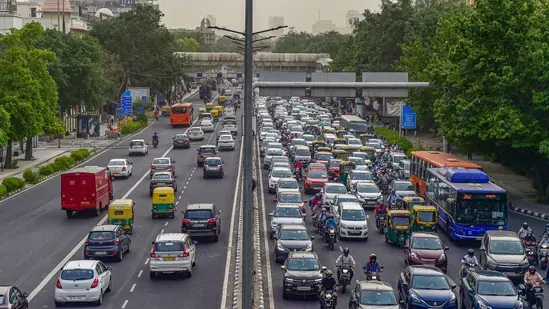
Photo: PTI
Rapid increase in vehicles has equally given birth to traffic congestion, accidents and pollution, writes ABHISHEK DAS.
Widening roads and flyovers may ease the traffic but as there is no end to desires and wants, the demand for wider roads and infrastructure development would continue taking a toll on Nature, environment and humans, until a sustainable alternative is attained.
The automobile industry in India has witnessed a great surge in the last 20 years. India is expected to be the world's third-largest automotive market in terms of volume by 2026. Currently, it contributes 7.1 per cent to the overall GDP of India. As the industry grows, so does the number of vehicles on the streets, and to accommodate them, the need for broadening of roads, flyovers, foot bridges has become an absolute necessity for the convenience of the citizens. However, the irony is that the rapid increase in vehicles has equally given birth to traffic congestion, fatality, pollution, felling of trees, etc.
India stood at the third spot when it came to the worst air quality index in 2020 as per IQ AIR (a Switzerland-based air quality monitoring organisation that measures pollution level around the world). However, Northeast India breathes cleaner air compared to other Northern parts of India, with Aizawl at the top of the list as per the Central Pollution Control Board (CPCB).
Chronic exposure to air pollution increases the likelihood of asthma, low birth weight, depression, schizophrenia, diabetes, stroke, lung cancer and can cause premature deaths.
In terms of road fatality, India recorded 3,74,397 accidental deaths in 2020.The number of accidental deaths in 2020 was, however, lower than 2019 due to restricted vehicle movement owing to the pandemic as per the National Crime Records Bureau (NCRB).
Agreed that infrastructure development facilitates easy movement of traffic and ensures safety of commuters but inadvertently, it boosts the ego and purchasing power of a consumer leading him to procurement of more vehicles. What if we turn the tables around by prioritising the limitation on procurement of cars, motorcycles, scooters, etc., by citizens rather than expansion of roads or construction of flyovers.
A regulatory body should be formulated for regulation on purchase of private vehicles. On purchasing a new car, a buyer has to present an NOC (No Objection Certificate) by concerned authority. This NOC would be issued to the person upon evaluation of his purchasing power, family size, numbers of vehicles the buyer owns already, reason for buying, availability of parking at his residence, criminal records (accidents, rash driving), etc.
If in case, the authority discovers the consumer owns or is about to own more cars than he needs, then issuance of NOC could be called off. For example, a family of six members can have a maximum of two cars for private use and one two-wheeler. A third vehicle can be owned only for commercial purpose. Also, one of the personal vehicles has to be either electric or gas operated. In certain exceptional cases, the authority could ease off some criteria.
Along with adaptation of such policies, imposing other measures such as high parking rate at public places, high penalty for parking in 'No Parking zone', convenient and more organised public transport, promotion of cycling, infrastructure for cycles, cycle rickshaws, odd-even driving policy, etc., can eliminate major traffic problems in India.
With the rise in income or earning capacity, a higher standard of living is giving birth to materialism. Back in the day, owning any car itself was a status symbol. That doesn't mean people were poorer then. Maybe people had limited desires as options were less. But primarily, more than debating needs and wants, it was not a trend to own a fancy car. When needs become wants and wants become trends, that's when people follow them. Back then, more than a necessity, it was not a trend.
So, widening roads and flyovers may definitely ease the traffic but as there is no end to desires and wants, the demand for wider roads and infrastructure development would continue taking a toll on Nature, environment and humans, until a sustainable alternative is attained.
